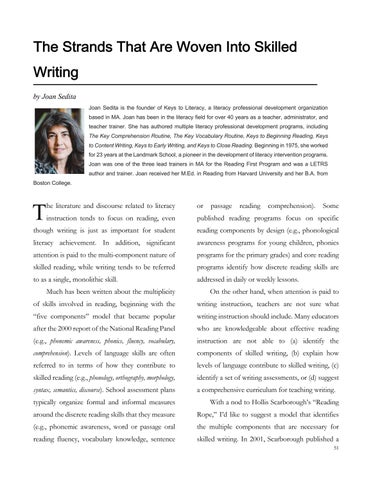>4.#A)/&"93#>4&)#!/.#8*C."#?")*#AF(--.9# 8/()("2# !
by Joan Sedita
! Joan Sedita is the founder of Keys to Literacy, a literacy professional development organization based in MA. Joan has been in the literacy field for over 40 years as a teacher, administrator, and teacher trainer. She has authored multiple literacy professional development programs, including The Key Comprehension Routine, The Key Vocabulary Routine, Keys to Beginning Reading, Keys to Content Writing, Keys to Early Writing, and Keys to Close Reading. Beginning in 1975, she worked for 23 years at the Landmark School, a pioneer in the development of literacy intervention programs. Joan was one of the three lead trainers in MA for the Reading First Program and was a LETRS author and trainer. Joan received her M.Ed. in Reading from Harvard University and her B.A. from
Boston College.
T
he literature and discourse related to literacy
or
passage
reading
comprehension).
Some
instruction tends to focus on reading, even
published reading programs focus on specific
though writing is just as important for student
reading components by design (e.g., phonological
literacy achievement. In addition, significant
awareness programs for young children, phonics
attention is paid to the multi-component nature of
programs for the primary grades) and core reading
skilled reading, while writing tends to be referred
programs identify how discrete reading skills are
to as a single, monolithic skill.
addressed in daily or weekly lessons.
Much has been written about the multiplicity
On the other hand, when attention is paid to
of skills involved in reading, beginning with the
writing instruction, teachers are not sure what
“five components” model that became popular
writing instruction should include. Many educators
after the 2000 report of the National Reading Panel
who are knowledgeable about effective reading
(e.g., phonemic awareness, phonics, fluency, vocabulary,
instruction are not able to (a) identify the
comprehension). Levels of language skills are often
components of skilled writing, (b) explain how
referred to in terms of how they contribute to
levels of language contribute to skilled writing, (c)
skilled reading (e.g., phonology, orthography, morphology,
identify a set of writing assessments, or (d) suggest
syntax, semantics, discourse). School assessment plans
a comprehensive curriculum for teaching writing.
typically organize formal and informal measures
With a nod to Hollis Scarborough’s “Reading
around the discrete reading skills that they measure
Rope,” I’d like to suggest a model that identifies
(e.g., phonemic awareness, word or passage oral
the multiple components that are necessary for
reading fluency, vocabulary knowledge, sentence
skilled writing. In 2001, Scarborough published a 51





